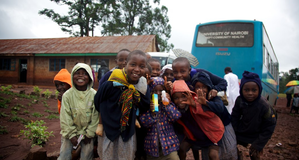Featured Article:Maternal Mortality in Nepal: Addressing the IssueFamily planning (FP) reduces maternal mortality by enabling women to prevent conception, which in turn eliminates the risk of unwanted pregnancy and mortality related to pregnancy. The USAID-Nepal launched the Nepal Family Health Program in 2001 to increase awareness and use of FP and MCHS (Puri et al., 2008). The program selected and trained FCHVs to deliver health education and MHS to women in their communities. CHWs, including FCHVs could play a huge role to mobilize these services into rural areas of Nepal. Another important component of our intervention would be to provide CHWs, including FCHVs, culturally competent trainings to disseminate FP related information and to provide FP services. This would be done in collaboration with organizations involved with MCHS, including Ministry of Health, WHO and other stakeholders. Increased efforts could be made by the government and partners involved to expand cross-cultural and educational trainings for all CHWs, and FCHVs in particular, so as to enhance their effectiveness, credibility and acceptability in various caste and ethnic groups. Smoking prior to or during pregnancy has been established as one of the risk factors for maternal mortality. Although, only 20% of women are engaged in smoking but the cumulative effect of first- and/or second-hand smoking is significant (NDHS, 2006). As a commitment towards reducing effects of smoking, Government of Nepal recently implemented ‘Tobacco Control and Regulation Act 2011’. Our intervention could include utilizing narrowcast media to reach population without access to broadcast media; as well as, direct education of mothers, their husbands, their mother-in-laws, and other family members to disseminate anti-smoking messages, announcements, and programs to induce change in behavior and discourage smoking. INGOs/NGOs that are concerned with MCH could assist in this process to reach to greater number of population. We could use street theater performance, a popular form of entertainment in Nepali communities as a means to convey important social messages. INGOs/NGOs could collaborate with local street performers, or train local amateurs to design and implement community street theater performances that present information messages about the importance of proper utilization of PC. These community street theater performances would be carefully designed to fit within the cultural framework and languages of specific communities. The lack of trained health care, particularly in rural parts of Nepal has significantly contributed to increased number of maternal deaths. One of the interventional components could include collaborative efforts of mother’s group (Aama Samuha), NGOs and governmental organizations to provide trainings and financial incentives to the FCHWs, CHWs to provide home-based delivery care, to conduct outreach programs and to recommend proper referral channel. These trained personal will encourage pregnant women and their families (husbands, mother-in-laws) to prepare and to plan for birth, postnatal period and any complications/emergencies that may occur. In addition, trained community leaders in schools, religion, and in vaccination posts and community health posts could also carry out some educational programs. In Nepal, many people follow superstitious beliefs such as the cause for maternal death to be evil spirit (Bokshi, Bhoot, Pret). Hence, people tend to prefer traditional healer, who provides them with amulets (Buti) to ward off evil spirit. Thus, the MM reduction intervention program could include teaching traditional healers to refer cases of maternal health to area health services. Using their competencies, CHWs could help train traditional healers how to diagnose pneumonia based on clinical signs including counting respiratory rate and using specific cutoff rates by age.Evidence has shown that MM, which majorly occur due to three delays, result from a culmination of violation of decision-making and human rights against women and girls (UNESCAP, 2010). Despite the progress that government has made in collaboration with different stakeholders, the larger problem of lack of education and empowerment of women is still an issue in Nepal. Our interventional component could focus on promoting women’s decision-making capacity through social mobilization, such as woman-to-woman peer support, testimonials of local people, engaging respected traditional practitioners, and building on benign traditional practices, to increase the priority communities give to pregnancy and childbirth, and their sense of responsibility and obligation. Including household members (husbands, mother-in-laws), local leaders, in galvanizing community action can ensure women’s voices are heard, and improve women’s access to MCHS. Women representatives in NGOs, women’s’ groups and mothers groups could play an important advocacy role in bringing related policy and program needs to the attention of municipal or VDC representatives at the local governance levels. Overall, our multilevel interventions to improve proper utilization of prenatal care to reduce MM will focus on increasing public awareness about maternal health and strengthening of facility- and home-based MCH services through community mobilization of trained health workers and use of local narrowcast media such as street theaters to reach to every household. We will also include components of cultural competency, technical skills and educational trainings for all CHWs, FCHVs and other individuals and groups (local volunteers, mothers groups) who are actively involved in the community, to enhance their effectiveness, credibility and acceptability by the community members. We will incorporate influential family members (husbands, mother-in-laws and others) responsible in women’s decision-making and their empowerment in all of our interventions. This process requires long-term time and resource commitment; therefore, collaborative efforts are needed from all stakeholders including individuals, local NGOs, educational institutions, government agencies and international organizations Outcome IndicatorsIt is difficult to determine whether maternal mortality interventions have been successful, partly due to complex interaction between prenatal care services and maternal death and also unavailability of the impact indicators such as maternal mortality. Reasons for this unavailability include the poor quality of vital statistics reported by many developing countries like Nepal and the fact that, when recorded, maternal deaths are often not distinguished from deaths by other causes. It is therefore recommended that programs rely on internationally agreed upon indicators: the MDG indicator of skilled attendance at birth and the six “UN EmOC process indicators.” As recommended by the Global health experts, we will base our outcome monitoring and evaluation based on the performance of variables such as functionality and accessibility of health services and change in knowledge, attitude and practice (KAP) related to use of prenatal care. Indicator 1-Proportion of deliveries assisted by skilled health personnel: In Nepal, most births take place at home, and many, particularly in rural areas, are not attended by a skilled birth attendant. We believe that equipping women and their families about knowledge of safe motherhood practice and resources available, helps to improve people’s perception about getting help of skilled healthcare worker during delivery, whether at home or at healthcare facility. Based on the pre- and post-intervention results, we will determine whether or not providing people with knowledge about MCH services have any impact on the use of these services. Indicator 2-Proportion of caesarean sections: It is a useful service indicator for many reasons. It is likely that C-sections are performed when women goes for prenatal visit and becomes aware about potential complication during delivery. Also, it is adequately recorded in hospital records. We will examine hospital records to determine the number of C-sections performed on women who were experiencing complications. This will provide us good insight about whether or not women used MHS after the implementation of our interventions. Indicator 3-Proportion of individuals using Family Planning (FP) services: Use of FP services helps women to avert unintentional pregnancies or to have safe birth spacing between children, thus, indirectly reduces risk of maternal mortality. Individuals, who have heard about FP during interventional activities, are more likely to use FP services such as contraceptives, birth-control pills, counseling, etc. Thus, as a part of our evaluation process, we will compare the number of people using FP services between pre- and post-intervention periods. Indicator 4-Proportion of abortions: Even a decade after Nepal legalized abortion in the first trimester of pregnancy, women still report not knowing where to get abortion or seeking illegal and unsafe abortions. Lack of awareness of the abortion law and stigma drives women to unregistered clinics, increasing the risks of maternal death. After our interventional activities on MCH services, we expect to see more women, with the cases of unwanted pregnancies, to utilize safe practice of abortion in registered clinics or hospitals. Indicator 5-Proportion of individuals prepared for delivery: Women, including her family members, who are aware about PC or received PC, tend to make preparation for delivery such as saving money, arranging transportation, contacting health worker, having safe delivery kit, etc. We will evaluate the impact of our intervention on this aspect by looking at the post-intervention data on the number of individuals who have made all necessary arrangements for delivery. Indicator 6-Proportion of deliveries in healthcare facilities: Deliveries at home without SBA are a major concern in Nepal. Many people perform ‘at-home’ delivery due to lack of awareness about potential complications, financial constrain, distance to health-facility, etc. Thus, looking at the proportion of place of delivery will provide us a good picture of effectiveness of our intervention; more delivery at the healthcare facilities signifying proper use of prenatal care.Continued on Next Page » Suggested Reading from Inquiries Journal
Inquiries Journal provides undergraduate and graduate students around the world a platform for the wide dissemination of academic work over a range of core disciplines. Representing the work of students from hundreds of institutions around the globe, Inquiries Journal's large database of academic articles is completely free. Learn more | Blog | Submit Latest in Health Science |
















